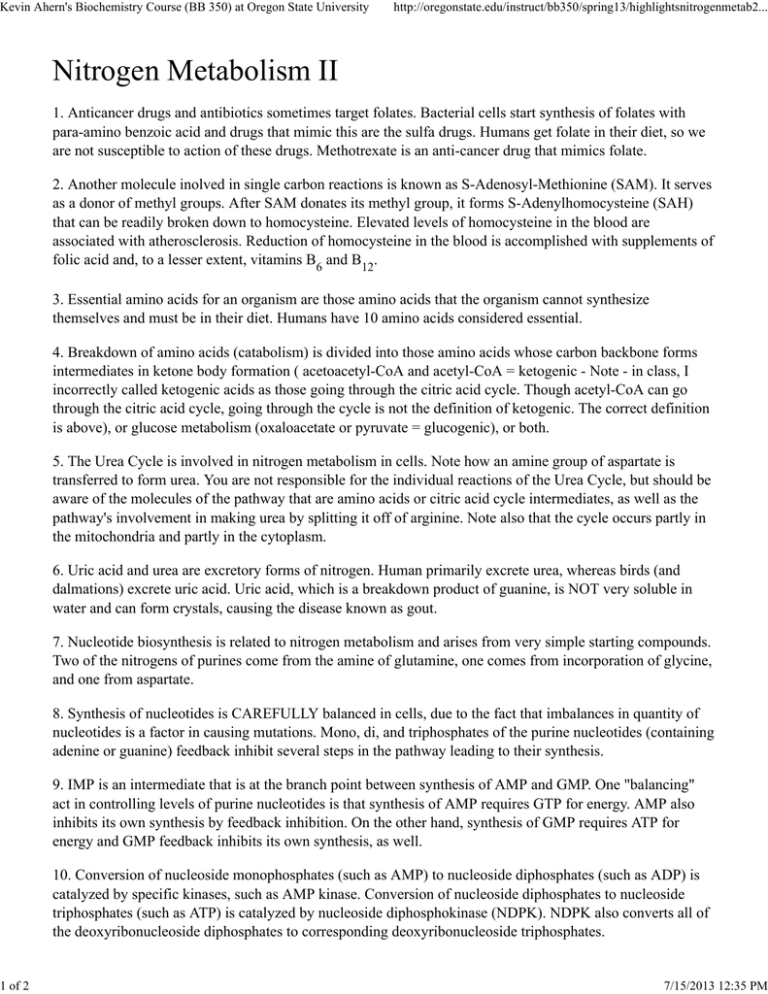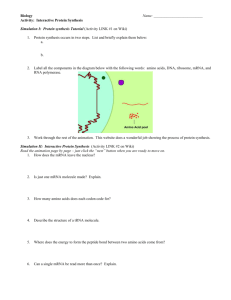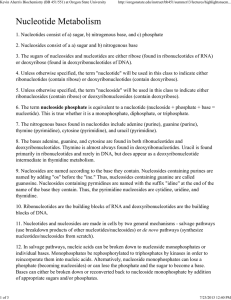Kevin Ahern's Biochemistry Course (BB 350) at Oregon State University
advertisement

Kevin Ahern's Biochemistry Course (BB 350) at Oregon State University 1 of 2 http://oregonstate.edu/instruct/bb350/spring13/highlightsnitrogenmetab2... Nitrogen Metabolism II 1. Anticancer drugs and antibiotics sometimes target folates. Bacterial cells start synthesis of folates with para-amino benzoic acid and drugs that mimic this are the sulfa drugs. Humans get folate in their diet, so we are not susceptible to action of these drugs. Methotrexate is an anti-cancer drug that mimics folate. 2. Another molecule inolved in single carbon reactions is known as S-Adenosyl-Methionine (SAM). It serves as a donor of methyl groups. After SAM donates its methyl group, it forms S-Adenylhomocysteine (SAH) that can be readily broken down to homocysteine. Elevated levels of homocysteine in the blood are associated with atherosclerosis. Reduction of homocysteine in the blood is accomplished with supplements of folic acid and, to a lesser extent, vitamins B6 and B12. 3. Essential amino acids for an organism are those amino acids that the organism cannot synthesize themselves and must be in their diet. Humans have 10 amino acids considered essential. 4. Breakdown of amino acids (catabolism) is divided into those amino acids whose carbon backbone forms intermediates in ketone body formation ( acetoacetyl-CoA and acetyl-CoA = ketogenic - Note - in class, I incorrectly called ketogenic acids as those going through the citric acid cycle. Though acetyl-CoA can go through the citric acid cycle, going through the cycle is not the definition of ketogenic. The correct definition is above), or glucose metabolism (oxaloacetate or pyruvate = glucogenic), or both. 5. The Urea Cycle is involved in nitrogen metabolism in cells. Note how an amine group of aspartate is transferred to form urea. You are not responsible for the individual reactions of the Urea Cycle, but should be aware of the molecules of the pathway that are amino acids or citric acid cycle intermediates, as well as the pathway's involvement in making urea by splitting it off of arginine. Note also that the cycle occurs partly in the mitochondria and partly in the cytoplasm. 6. Uric acid and urea are excretory forms of nitrogen. Human primarily excrete urea, whereas birds (and dalmations) excrete uric acid. Uric acid, which is a breakdown product of guanine, is NOT very soluble in water and can form crystals, causing the disease known as gout. 7. Nucleotide biosynthesis is related to nitrogen metabolism and arises from very simple starting compounds. Two of the nitrogens of purines come from the amine of glutamine, one comes from incorporation of glycine, and one from aspartate. 8. Synthesis of nucleotides is CAREFULLY balanced in cells, due to the fact that imbalances in quantity of nucleotides is a factor in causing mutations. Mono, di, and triphosphates of the purine nucleotides (containing adenine or guanine) feedback inhibit several steps in the pathway leading to their synthesis. 9. IMP is an intermediate that is at the branch point between synthesis of AMP and GMP. One "balancing" act in controlling levels of purine nucleotides is that synthesis of AMP requires GTP for energy. AMP also inhibits its own synthesis by feedback inhibition. On the other hand, synthesis of GMP requires ATP for energy and GMP feedback inhibits its own synthesis, as well. 10. Conversion of nucleoside monophosphates (such as AMP) to nucleoside diphosphates (such as ADP) is catalyzed by specific kinases, such as AMP kinase. Conversion of nucleoside diphosphates to nucleoside triphosphates (such as ATP) is catalyzed by nucleoside diphosphokinase (NDPK). NDPK also converts all of the deoxyribonucleoside diphosphates to corresponding deoxyribonucleoside triphosphates. 7/15/2013 12:35 PM Kevin Ahern's Biochemistry Course (BB 350) at Oregon State University 2 of 2 http://oregonstate.edu/instruct/bb350/spring13/highlightsnitrogenmetab2... 11. Purine breakdown (catabolism) goes through the intermediate Xanthine, which is broken down to uric acid and ultimately to glyoxylate and urea. Uric acid crystals are the causes of the painful disease known as gout. 12. ATCase is the primary regulatory enzyme of pyrimidine biosynthesis. It provides balance between purines and pyrimidines, since it is activated by a purine (ATP) and inactivated by a pyrimidine (CTP). 13. Pyrimidine synthesis also includes very simple precursors, such as amino acids. The first pyrimidine nucleotide made is UMP and from it UDP, UTP, and CTP are made. 14. Deoxyribonucleotides (building blocks of DNA) are made from ribonucleotides (building blocks of RNA) using the enzyme ribonucleotide reductase (RNR). Note that the precursor ribonucleotides are DIPHOSPHATES and that the reaction simple reduces the hydroxyl group on the ribose ring to a hydrogen, thus making deoxyribose as the sugar on a deoxyribonucleotide. 15. Thymidine nucleotides are made from uridine nucleotides. The process goes as follows: UDP goes to dUDP. Then, several reactions later, dTTP is made. It has been a great term, folks. I wish you the best and I hope you will stay in touch. Good luck to you. 7/15/2013 12:35 PM





